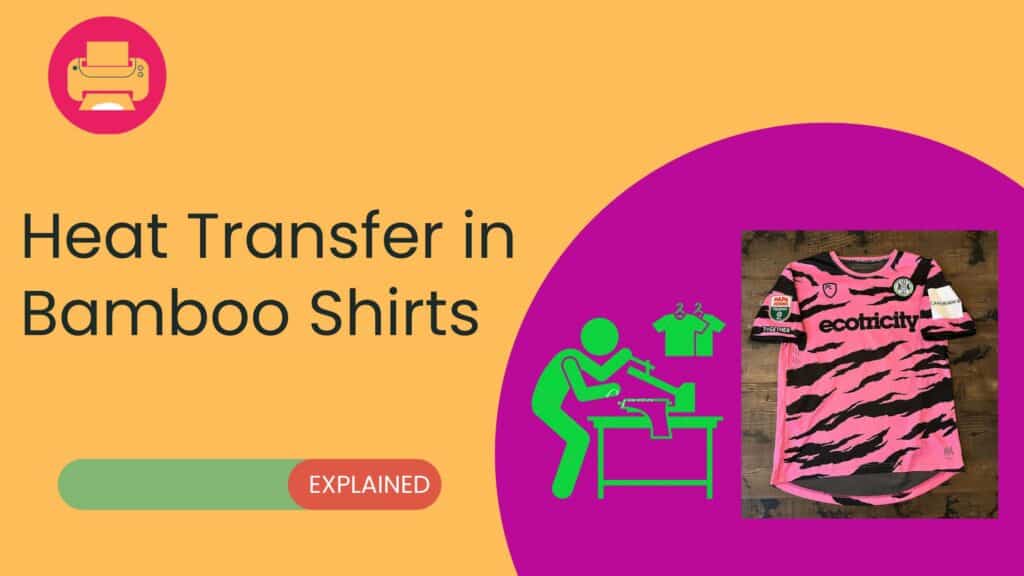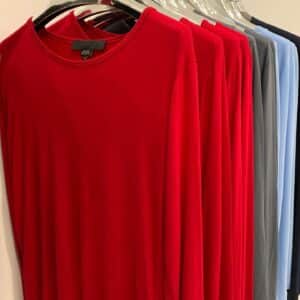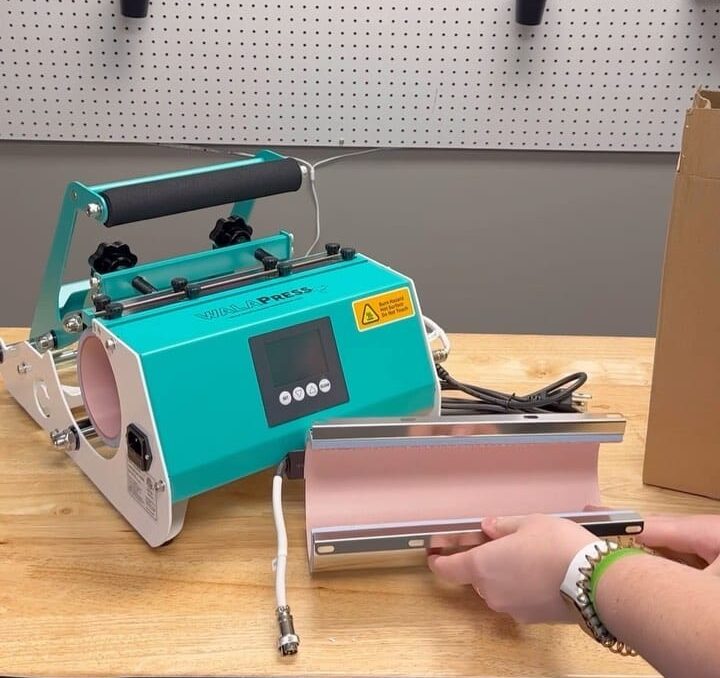In the world of fashion, bamboo shirts have become a popular and environmentally friendly option because of its comfort, breathability, and eco-friendliness. The trend of personalizing and customizing these shirts using heat transfer is growing along with their popularity. But the issue still remains: Is it possible to use heat transfer methods on bamboo shirts?
This blog article explores the possibility of heat transfer on bamboo cloth, a fascinating junction of customisation and fashion. While companies use thermal transfer techniques to customize apparel for decades, the unique properties of bamboo fabric present unique challenges and opportunities.
We’ll explore bamboo fabric, heat transfer processes, and this interesting process’s dos and don’ts in the following sections. This blog article intends to be an all-in-one resource for everything from fashion enthusiasts to clothing company owners to those who are just inquiring about the possibilities of personalizing bamboo shirts. See whether bamboo shirts can handle customized heat!

Heat Transfer Techniques for Bamboo Shirts
Heat transfer methods can customize bamboo shirts and other surfaces. Here, we’ll go over the basic toner heat transfer procedure, suggested tools and add-ons, and the essential actions to take in order to get great outcomes.
Recommended Equipment & Accessories
- Printer for Heat Transfer: A DTF printer made especially for applications involving heat transfer.
- Heat Transfer Paper for Hard Surfaces: For optimal results, choose the suitable heat transfer paper and adhere to the paper’s instructions.
- Standard Flat Heat Press: An essential tool for applying heat and pressure evenly.
- During the heat transfer procedure, transfer paper is held in place with the use of heat tape. To avoid sticking or burning, use a Teflon sheet or blowout paper on top of the transfer paper.
- Heat Gloves: Use heat gloves when handling hot items.
Recommended Settings
- Time: 60-70 seconds.
- Temperature: 300°F.
- Pressure: Heavy.
General Heat Transfer Instructions
- Heat Transfer Paper Instructions: Read and follow the heat transfer paper instructions before starting. This stage ensures the best outcomes.
- Press Pressure Adjustment: Press hard with your heat press. Sufficient pressure is necessary to ensure a successful transfer.
- Preheat the Heat Press: As directed by the paper specifications, preheat your heat press to 300°F. Turn the heat pad’s temperature down to 325–335°F if you’re using one. Proper preheating is crucial for even heat distribution.
- Print and Set Up the Transfer Sheet: Make sure your design is properly positioned and print it onto the heat transfer paper. Lay the transfer sheet on top of the bamboo shirt, facing down. In order to ensure that any effects between the edge of the transfer paper and the fabric may be visible, the edges of the transfer paper should be somewhat smaller than the shirt’s edges. Use hot tape to firmly attach the transfer sheet.
- Position the Product on the Heat Press: Using the transfer paper on top, place the bamboo shirt with the connected transfer sheet onto the heat press platen.

- Apply Blowout or Teflon Paper: Place a piece of Blowout or Teflon paper over the Transfer paper. This layer prevents transfer paper from adhering to the heat press and promotes smoothness.
- Close and Press: Close the heat press and press for the recommended time (60-70 seconds). The pattern will transfer more easily onto the bamboo cloth, thanks to the pressure and heat combination. Once pressing is complete, open the press and gently remove the Teflon or blowout paper from the transfer sheet.
- When the bamboo shirt is safe to handle without the gloves but still hot or warm, take it from the press while wearing heat gloves.
- Peel the Transfer Paper: Gently remove the transfer paper while the product’s surface is still heated. After completing this process, the bamboo shirt should have your personalized design printed on it.
These settings and heat transfer instructions can let you customise bamboo shirts with unique patterns and artwork. Try, learn, and enjoy the many creative possibilities that heat transfer presents when it comes to personalizing bamboo cloth.
Tips and Tricks
Take Advantage of Product Templates: Make use of the product template that is offered on the product page to get the ideal picture alignment and placement. These bamboo shirt templates help you place your design precisely.
Think About Silicone Heat Pads: It’s best to set the temperature to 330°F if you’re using an orange silicone heat pad. For consistent results, be careful to adjust the temperature in accordance with the potential differences in heat resistance among different heat pads.
Test Before You Transfer: Try your design on an old shirt or a scrap piece of cloth before transferring it to the bamboo shirt. This enables you to adjust parameters precisely, guaranteeing that the finished result is just what you had in mind.
Preheat the Press Appropriately: Before putting your bamboo shirt and transfer paper in, make sure the heat press is heated to the proper temperature. A good transfer requires consistent heat distribution, which preheating provides.
Use High-Quality Heat Transfer Paper: Make an investment in heat transfer paper that has speciality in for bamboo cloths. Quality paper improves transferred design brilliance and durability.

Secure Transfer Paper with Heat Tape: To firmly adhere the transfer paper to the bamboo shirt, use heat tape. As a result, there is no movement during the heat transfer process, guaranteeing accurate alignment.
Verify Pressure Settings: Use the specified heavy pressure. While too much pressure might harm the fabric or pattern, too little pressure can lead to incomplete transfers.
Remove Transfer Paper While Warm: The bamboo shirt must be removed from the transfer paper as soon as it is warm. Too much waiting might reduce adhesion and transfer quality.
Use heat-resistant gloves whenever you handle hot objects, like the bamboo shirt immediately after the transfer procedure to protect your hands. Safety should be a priority during customization.
Be Patient: Before wearing or washing the bamboo shirt, let it cool fully. This makes it more likely that the transferred design will stick well and hold up over time.
Record Your Procedure: Note all of the configurations, temperature changes, and other particulars pertaining to your heat transfer procedure. This documentation will help with future projects and difficulties.
Try New Things and Experiment: Don’t be scared to try out new designs, color schemes, and heat transfer methods. Innovation often produces remarkable and original outcomes.
These tips and tactics will help you master heat transfer and make magnificent, individualized bamboo shirts. Always keep in mind that practice makes perfect, so continue honing your methods to get the best possible outcomes.
Troubleshooting
You can solve the problems with heat transmission on bamboo shirts with the correct troubleshooting techniques. Here’s how to deal with a few typical issues:
Insufficient Transfer of Images:
Problem: The bamboo shirt did not fully transfer the picture.
Solution: To improve the transfer paper’s and the fabric’s contact, slightly raise the press pressure.
Peeling the product might reveal that it’s still too heated, which would leave the transfer unfinished. To remove the transfer paper, give the product a little more time to cool down.
Verify Hard Surface Paper Compatibility:
Problem: The bamboo shirt did not take the transfer very well.
Solution: Verify that the bamboo cloth and the hard surface paper you selected are compatible. Hard Surface papers come in a variety of varieties for different kinds of materials, and effective transfers depend on selecting the right kind.
Inconsistent or Spotty Transfer:
Problem: the picture that was transferred seems smeared or uneven.
Solution: During the heat transfer process, make sure that pressure is applied uniformly across the whole surface of the bamboo shirt.
Verify that the press’s temperature remains constant to avoid variances in the transfer.

Dim or Fading Colors:
Problem: The copied design’s colors seem muted or faded.
Solution: Verify that the heat transfer paper you are using is of the highest quality, made to have vivid colors and longevity.
As directed by the transfer paper instructions, make sure the heat press is adjusted to the proper temperature and duration. Incorrect settings distort color.
Image Sticking to Teflon or Blowout Paper:
Problem: The blowout or Teflon paper adheres to the transfer paper.
Solution: To avoid excessive sticking, change the pressure and temperature settings. Too much heat or pressure can adhere paper to the protecting layer.
Design Smudging or Blurring:
Issue: After transfer, the design seems smeared or blurry.
Solution: To prevent smudging during the transfer, make sure the design is printed clearly and with great quality.
Ensure that the bamboo shirt is wrinkle-free and perfectly flat before beginning the heat transfer procedure.
Adhesive Residue on the Shirt:
Problem: After removing the transfer paper, there is still adhesive residue on the bamboo shirt.
Solution: Gently wipe the garment of any residue using rubbing alcohol or adhesive remover. Exercise caution so as not to harm the transferred design.
These frequent challenges and solutions might help you fix heat transfer concerns on bamboo shirts and get professional-quality results. Recall that the secret to mastering heat transfer methods is patience and practice.
Understanding Bamboo Fabric
Bamboo fabric’s exceptional attributes and environmental friendliness have made it more well-known in the textile business. This fabric is made from the pulp of bamboo plants. It is sometimes compared to cashmere or silk because of its plush and velvety texture. It’s a great material for clothes because of its inherent breathability, particularly in warm, humid regions.
Its sustainability makes bamboo cloth stand out. Bamboo is an eco-friendly choice since it grows quickly, needs little water, and doesn’t need pesticides. Bamboo is also inherently resistant to smells and allergies due to its antibacterial qualities, which makes it more appealing to those who have sensitivity issues.
Additionally, bamboo fabric has the ability to efficiently drain away perspiration from the skin, keeping the user comfortable and dry. Moreover, bamboo cloth decomposes naturally, hence mitigating its environmental effect.
Bamboo cloth has several benefits, however processing might affect its quality. To increase its elasticity and durability, we often combine bamboo fabric with other fibers, such as spandex or cotton. All things considered, bamboo fabric is a monument to the resourceful and adaptable textile solutions that are out there, providing consumers with design, comfort, and environmental concern.
Conclusion
Bamboo shirts have become a popular sustainable canvas for personalization in the fashion industry. While heat transmission into bamboo cloth is difficult, it is doable with the correct procedures and requirements.
As we’ve seen in this article, good heat transfers on bamboo shirts depend on using the right tools, following the suggested settings, and doing troubleshooting correctly. With a little imagination, perseverance, and attention to every little thing, you can turn these eco-friendly clothes into one-of-a-kind pieces of art.
So go ahead and tackle those heat transfer projects, take heed of the suggestions on tips, tactics, and troubleshooting, and unleash the creative potential of bamboo shirts. Personalization is in store, and there’s never been a more exciting combination of sustainability and fashion.
FAQs
No, using heat transfer paper made especially for bamboo cloth is essential. Correct paper type provides adherence and bright outcomes.
You can use an iron, but for uniform results and equal heat distribution, we recommend a heat press. If using an iron, ensure you apply even pressure and maintain the correct temperature.
It’s possible to wash them, but it’s best to refer to the care guidelines that come with the heat transfer paper. The longest lasting designs are usually preserved by washing inside out in cold water and staying away from chlorine and abrasive detergents.
Yes, you can create multicolored designs. Make sure every color is on a different piece of transfer paper, and adhere to the suggested heat and duration settings for each color.
To avoid the transferred design from cracking or fading, use high-quality heat transfer paper, use specified settings, then wash and care according to instructions.
As long as you modify the temperature appropriately, you can employ a heat pad. We strongly urge to use an orange silicone heat pad at 330°F.
Prior to the transfer procedure, make sure the bamboo shirt is wrinkle-free and flat. Try not to apply too much pressure or heat to the cloth as this might burn it or cause damage.
It’s usually not a good idea to re-transfer a design to the same spot because it can make the design not stick well. Before trying another transfer on a different part of the shirt, it’s best to practice on a scrap piece of cloth.
It is possible to use the same methods of heat transmission to a variety of bamboo-based goods. Follow the same rules and make sure the product is appropriate for heat transfer.
Due to bamboo fabric’s distinctive texture, layering can be difficult. Do a scrap piece test before trying layered patterns for optimal results.

Ashley Wang is a skilled sales manager with knowledge in DTF printing. She presently works for ShenLan Digital, a reputable DTF printer maker. Ashley is the best person to offer advice on selecting the most suitable DTF printer because she has tested a lot of them. She launched DTFPrinterSchool to educate individuals and organizations about DTF printing technology, providing her expertise and observations on the most recent advancements in the sector. Ashley is an invaluable resource for businesses and individuals wishing to invest in DTF printing technology because of her expertise and experience in the industry.
